6.1 Introduction
In this chapter, I explore the role that apologies play in the discourse surrounding public inquiries and in particular, how they relate to the construction of blame in these speech activities. This chapter breaks with the established pattern of the book so far, in that it is a thematic treatment of one speech act—namely apologies—rather than looking sequentially at how an inquiry is conducted. That having been said, the chapter will look at apologies produced at different stages of inquiry procedure: before the oral evidence, during the oral evidence and following the publication of the final report of the inquiry. I will outline the differences in the form and nature of the apologies produced at these different points.
My interest in apologies before, at and after inquiries stems from the view presented by others that implicit in such a speech act is the acceptance of responsibility by the apologiser for an action deemed to be an offence (see amongst others Murphy 2015; Ogiermann 2009). To this end, apologies may be viewed as actions which accept blame, or perhaps even as ‘self-blaming’ actions. I shall explore this idea in this chapter.
The chapter will first outline what is meant by an apology—how it is performed and what is intended by and/or interpreted by this type of act. We will see that there exists some debate both within interactional linguistics and between this area and neighbouring disciplines (e.g. philosophy and sociology) about what constitutes an apology. The aspect of this debate which is of especial interest relates to the face considerations which are said to be involved in the production of apologies. These matters will be the focus of Sect. 6.2.
I go on in Sect. 6.3 to outline the little work which has been carried out on apologies at public inquiries. I will show that this previous work does not share the goals of this chapter.
I will then move on to exploring some case studies of apologies made in the course of and as a result of public inquiries. In particular, the focus will be on questions of when, how and why these particular statements are made. Careful consideration will be given to the pragmatics of such apologies—i.e. I will explore whether what is said matches up to what is meant in inquiry participants’ testimony, and in the events which follow a public inquiry.
In Sect. 6.4, I discuss apologies which are produced before an inquiry commences and show that such statements are unusual. They tend to be given for offences which are not the focus of the inquiry proper. The reasons for this are explored.
I then give an account of the apologetic features of witnesses’ oral evidence in Sect. 6.5. I show how indirectness in these statements is prevalent. I discuss also the fact that the accounting behaviours outlined in Chapter 4 are a major feature of the apologies producing during the inquiry. I conclude this section by exploring the idea that witnesses undertake a cost-benefits analysis as they judge whether or not to apologise.
The largest section of this chapter explores how politicians apologise after an inquiry, with a particular focus on set-piece parliamentary statements. Section 6.6 analyses these statements and finds how they are quite unlike any other parliamentary activity. Aside from analysing the forms of apology found in these statements, I discuss why I think these actions are legitimate—despite criticisms made of them from some quarters. I also demonstrate that these apologies can be put to party political uses, rather than the interpersonal function usually associated with remedial work.
6.2 Defining Apology

We can intuitively say that such an utterance does not constitute an apology. The obvious possible exception might be where the speaker killed the person in question, but even then (for other reasons), one would struggle to argue that it truly constitutes an apology. I shall return to the importance of apologising for the right thing a little later in this chapter.
The reason why I think we can intuitively reject some I’m sorrys as being apologies relates to how they can be defined in terms of their function. In Murphy (2015), I sketched a set of felicity conditions for the act of apologising which incorporated public apologies made by politicians and other public figures—a reason why this set is to be preferred for our purposes over others by, for instance, Ogiermann (2009) or Owen (1983). Apologies, according to the functional approach, are considered indicators that the speaker regrets and act for which she, or someone for whom she is a recognised representative, is responsible and that the act is (believed to be) an offence against the apology’s recipient. Thinking of apologies in this way should already be reminiscent of the definition alighted on for the notion of blame—the assigning of responsibility to an individual or group for a negative action. In light of this, the reason for investigating apologies as part of a wider study on the construction of blame should be clear.
Considering the apology in this way—particularly the notion that the apologiser is either directly or indirectly responsible—gives something for an explanation for why when (102) is uttered at a funeral, it would be interpreted as a statement of sympathy, rather than an apology, since it fails the responsibility test. But the same utterance produced by, for instance, a government minister to some who was bereaved as a result of a government action may well be interpreted (at at the very least, interpretable) as an apology. Here, the utterer passes the same responsibility test.
The function of apologies at the perlocutionary level—i.e. what effect they (are intended to) have on the hearer has been widely discussed in both interactional linguistic and sociological literature. Relying on the concept of face —‘the positive social value a person effectively claims for himself (sic.)’ (Goffman 1967: 5)—previous work has come to conflicting views about the (social) function of apologies. Edmondson and House (1981) contend, for instance, that apologies are hearer-supportive devices intended to attend to the face wants of the hearer. Meier (1998) takes the opposite view arguing that speakers produce apologies in order to boost their own face, by showing they are sensitive to their hearer’s needs. Holmes (1990) takes a more reasonable view in suggesting that apologies perform both tasks—appealing to both speaker and hearer (or put another way: the self and the other).
Whilst this is more reasonable, this view still misses an important point: apologies carry with them some risk. As I have mentioned, apologies entail the notion that the speaker is responsible for some wrongdoing. If the hearer was unsure of the source of the wrongdoing before the apology, he is no longer uncertain of this after it; this has the potential to cause damage to the relations between the speaker (=apologiser) and the hearer (=recipient, or apologisee). Moreover, the hearer’s face is put at risk by the apologiser, since he feels under pressure to accept the speaker’s apology—impeding on his freedom to do as he pleases. So apologies at a basic interactional level are far from risk-free, and this is before we factor in more macro-level considerations such as legal and political constraints, which are naturally more of a consideration at public inquiries than in other non-legalistic aspects of public life.
In this chapter, I seek to examine the interplay of these socio-interactional considerations, alongside legal and political ones, when it comes to apologising during and as a result of the inquiry process.
6.3 Previous Work on Apologies at Inquiries

In cases like (103) the use of sorry is a marker that the self-initiation of self-repair is incipient. These apologies, and a number of the other types which I identify at the Leveson Inquiry play an important role in facilitating the smooth running of the inquiry. In other words, they are truly interactional in nature. Whilst the apologies may be for tangible offences, for instance speaking too quickly for the stenographer to keep up with transcribing, they are not apologies related to the offences which the inquiry is tasked with investigating. It is apologies of this type which will be the focus here.
The reason that I will exclude these interactional apologies is, I hope, clear. I do not believe that they play a role in the construction of blame. Whilst a witness may be very apologetic for, say, interrupting counsel, that does not mean that she will be prepared to apologise for an offence related to the inquiry’s Terms of Reference. I do envisage one potential source for overlap between the present investigation of inquiry apologies and that found in Murphy (2016). This relates to what I described in that work as ‘evidence offences’ (Murphy 2016: 605–606). This category of apology collects together instances of witnesses providing incorrect information to the Inquiry or being unable to answer counsel’s or the chair’s question(s). This type of behaviour may be a source for criticism and/or used in the assignment of blame in the Inquiry’s report. For this reason I do not exclude this type of apology out of hand in this chapter.
A second point of departure from my previous work into apologies in this setting is that I am not particularly interested in their sequential organisation in this work. I found previously that apologies do not require a response in this setting, as they do in everyday talk, where Robinson (2004) argues that apologies are first-pair parts in an adjacency pair. Sequential consideration are less of a concern here, though they will be touched upon when we look at what triggers these utterances. The interest here relates more to how the apologies are (per)formed.
6.4 Pre-inquiry Apologies
If apologies presuppose the acceptance of responsibility, and inquiries set out, at least covertly, with the intention of assigning responsibility, then one would anticipate that it would be quite exceptional for any party to apologise before the inquiry commences. It certainly is exceptional to find pre-inquiry apologies, but they do exist. In this section, I will explain why they can come about.
I have previously cited the inquiry into the death of Azelle Rodney, who was shot by an armed policed officer following a so-called tactical stop on the vehicle he was travelling in. I noted the length of time taken between Rodney’s death and the establishment of the inquiry. It was for this delay that the government lodged an apology with the European Court of Human Rights not long before the inquiry was instituted. It is unfortunate that the nature of this apology cannot be investigated further because the Coronial Service of the Ministry of Justice refused to release it despite my repeated requests under the Freedom of Information Act.

The defensive response from the Ministry of Justice exemplifies something which I have already mentioned (and shall return to) that apologies may be viewed as being inherently risky actions, particularly for governments. Rather than simply risky for social relations as outlined in Sect. 6.2, the view put forward in (104) suggests that apologies (or discussion thereof) are risky from a legal perspective, too. The choice to make an apology as part of an out-of-court settlement is also indicative of a second important aspect of institutional apologies—they may be made as a means of avoiding more serious censure; in this case, some form of reprimand from the European Court of Human Rights. This has the potential to undermine the sincerity of such apologies, since they may be viewed as having been carried out only under duress. The trigger for an apology, therefore, has a bearing on the interpretation of the act itself.
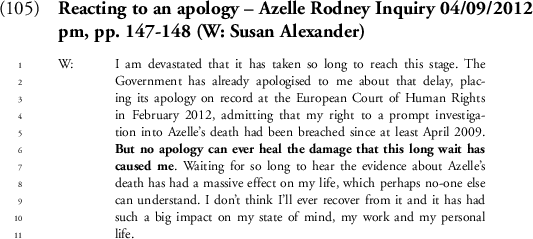
Through all of these [ritual performances – JJM] the recipient is told that he is not an island unto himself, and that others are, or seek to be involved with him and his private concerns. (Goffman 1967: 73)
This is a matter which will crop up again when I discuss post-inquiry parliamentary apologies.
But what must be noted about these pre-inquiry apologies is that they are for matters which are not the main focus of the inquiry. In this case, for instance, the inquiry is tasked with establishing how Rodney died. As such, it is highly unlikely that the inquiry report will focus on the delay in coming to its findings, i.e. the focus of the government’s apology. So there is a limit to the nature and scope of the apologies which are given before an inquiry begins its investigations proper. The motivations for limiting the scope of an apology is something which will be returned to later in this chapter.
6.5 Apologies in Oral Evidence
Once we exclude apologies for interactional offences, we find only a limited number of ‘proper’ apologies during the evidence giving phase of an inquiry. This should not come as a surprise, given that most participants in an inquiry will not have overtly accepted their responsibility for the events under investigation. As a result, it is unlikely that apologies would arise frequently. The cases where apologies do come about merit further investigation and I shall explore them in this section. In addition I shall consider in more detail the calculations which a witness (subconsciously) makes when deciding whether or not to apologise.
6.5.1 Conditional Apologies
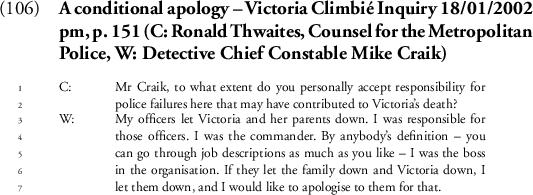
The senior police officer’s desire to apologise is conditional on if his staff let down the Climbié family. In this respect, he can be argued to only be apologising if the hearer believes that this condition is sufficiently met. In Murphy (2018), I found that these conditional apologies are treated as apologies proper by only a third of respondents. However, the case before us here is less clear cut, since the earlier part of his response suggests that the conditionality associated with the apology has already been met.

if I use some linguistic expression that fails to commit me to some embedded proposition, in preference to another available, stronger expression that would so commit me, then I may be taken to implicate that I am not in the (epistemic) position to make the stronger statement. (Levinson 1983 : 136)
In the case of ‘if p (then) q’, the speaker does not commit themselves to the truth of the proposition p. If the speaker wished to do this, then they would use the equally available and straightforward parallel structure of ‘since p, q’. By not using this, the speaker conversationally implicates that this is not the case.
So to return to the example, if we isolate this from the surrounding discourse context, it is reasonable to assert that Craik conversationally implicates that he does not have sufficient knowledge to believe that his officers let down Victoria. However, there are two important points to be made here: (i) conversational implicatures are defeasible (in other words, can be cancelled with further context or with an explicit statement) and (ii) we do have the discourse context available to us to call into question the generation of the conversational implicature.
We can see from the commander’s earlier assertion that the proposition p is true—i.e. he does have reason to believe and indeed he does believe that his officers let down Victoria Climbié . With this in the common ground, the implicature (that he cannot be certain of p and therefore, that q does not necessarily obtain) evaporates. But getting to this point takes processing effort on the part of the hearer. Moreover, whilst there is an assertion in the common ground which does cause the implicature to evaporate, it is not directly adjacent to the if-clause—this adds to the processing strain on the hearer.
It is an open question as to why Craik does not use an alternative construction e.g. Since my officers let the family and Victoria down, I let them down. Such a construction would be a functional equivalent, given that the clausal-level implicature of the if-clause is blocked.
However, one explanation takes us back to what Kampf (2009) has to say about the motivation of politicians producing non-apologies, and what Lee and Pinker (2010) provide as a rationale for indirect speech. Kampf (2009: 2269) notes that ‘even an incomplete form [of apology] may be accepted if the offended is motivated to forgive’ and so ‘doing’ an apology in this way may allow a speaker to reap the rewards of performing the action, whilst minimising the risks associated with it. The risks are minimised because the speaker could, if it became necessary, deny that the statement was a proper apology, i.e. one which entailed an admission of liability. Here, ‘indirect speech is a solution to potential conflicts of interest among speakers’ (Lee and Pinker 2010: 802) since it affords an ‘out’ to the apparent apologiser. How plausible any such denials would be is an open question.
6.5.2 Indirectness in Apologies

Looking just at the conventional apology expression (in bold), we can first see that this is similar to, but in some ways removed from, an explicit apology token of ‘I apologise’. Indeed, it might argued that it is ‘twice-removed’ from such an explicit expression. Let us first deal with one of the propositions contained in the expression, namely I want to apologise. Here the speaker does not explicitly perform the act of apology but rather expresses his desire to apologise. What is performed is an indirect speech act, in other words, whilst literally saying one thing, the speaker may be taken to be doing another thing (see Searle 1979: Chapter 2).
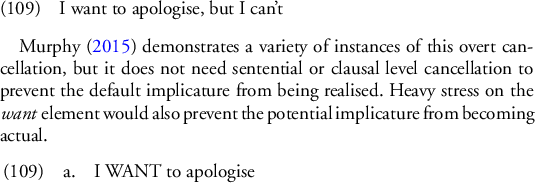
leaves the explicit cancellation elliptical in some way.
But returning to what is said in example 108, the speaker is even more indirect than this—there is a second implicature in his statement. I would want to apologise suggests that there is some level of conditionality on the desire to apologise. This sort of distancing is frequently used for reasons of politeness (Brown and Levinson 1987), but here I think the more likely explanation goes back to what I suggested about conditionality—the speaker leaves themselves with an ‘out’. This sort of strategy is seen not only in this example, but in the previous one (106), and the example in the next subsection (110).
Before I move on from this example, there is a further aspect which merits discussion—namely, the question of who is apologising and how this is explicitly framed in the statement. The apologiser produces his statement ‘as an NHS professional’. In doing so, he invokes a specific part of his identity—orienting to his transportable identity (Zimmerman 1998). This has two potential effects: (i) it may be seen as distancing himself from the apology; it is only as an NHS staff member that he is apologising, i.e. in his professional capacity and not in a personal one; (ii) the apology may be taken as being on behalf others who would also self-identify as NHS professionals, and as a result, diffusing the responsibility for it amongst a wider group of people. I will come to apologies on behalf of others in more detail later in this chapter.
6.5.3 Accounting and Apologies
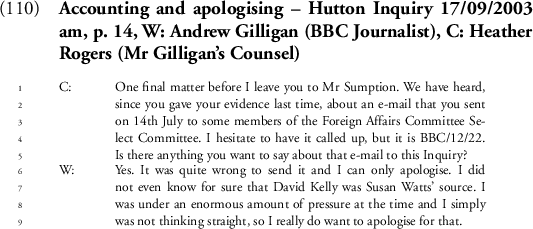
The apology here relates to actions which Gilligan undertook during his time as a BBC journalist. He had sent an email to members of the House of Commons Foreign Affairs Select Committee which revealed Dr. David Kelly as the source for the suggestion that members of Number 10 had ‘sexed up’ the claims made in the infamous so-called ‘dodgy dossier’. This dossier was the document which was used as the basis for convincing MPs that Saddam Hussein was in possession of Weapons of Mass Destruction; this was a key part of the decision to go to war in Iraq.2 The BBC as an institution were seeking to protect the source of this claim and Mr Gilligan’s email went against BBC policy and usual journalistic norms and practices of not revealing sources of information.
In providing his apology for this transgression, Gilligan does not deny its serious; indeed, he makes clear its seriousness in that he acted without even being certain of the truth of the information he was passing on to the Select Committee. Note that the form of his initial apology is indirect, as we have seen in previous examples. ‘I can only apologise’ is literally a statement of his ability and the limits of what it is possible for him to do in these circumstances, but by default this will ‘go through’ as an apology proper. This statement suggests that Gilligan is of the view that apologies are a potential remedy for his actions; by placing the apology at the extreme end of the actions which he is able to perform, Gilligan seeks to frame his apologetic stance as being an act which should be taken seriously.
However, this apology is accompanied by an account of his actions, and this may be taken to undermine his attempts to show contrition. This may be especially true because his account takes the form of an excuse, rather than a justification, which I discussed in Sect. 4.3.2 and which are generally more poorly received by hearers. His excuse sees him seek to cause others to question the capacity he had at the time of committing his actions, which in turn may reduce the amount of blame he is liable for. Also implicit, but not asserted, in his statement is that the ‘enormous amount of pressure’ he was under may have amounted to coercive pressure; in other words, that his actions were not simply his own. Again, accounting in this way may have the potential of minimising the blame which is attributed to him. However, accounting whilst apologising is not without risk. I stated at the outset of this chapter that apologising can be considered an action in which a speaker accepts responsibility for a negative action. By engaging in exculpatory behaviour, the speaker may be seen as seeking to shirk their responsibility and as such failing to sincerely apologise. Because of this, accounting may be counter-productive and undermine the efforts that a speaker goes to in apologising. It is for this reason, I believe, that Gilligan does work to attempt to counter this perception. Following his account, he produces a further apology (I really do want to apologise)—and here he is more emphatic (albeit still indirect in the sense outlined). He uses do-support, which is a means providing positive, emphatic polarity and, in addition, the use of the adverb really suggests an appeal that he is being truthful in what he says. Such a statement may go some way to defending against the idea that his account undermined the sincerity of the initial apology.
6.5.4 Volunteering an Apology
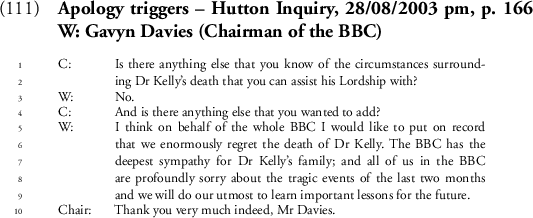
The form of the apology remains indirect, as has been discussed. But the nature of this indirectness relies on the ambiguity of regret and sorry, and for some hearers would not necessarily be treated as an apology proper. Instead, the expression of regret and the speaker being sorry about the events (rather than for them), coupled with the sympathy felt may mean that hearers treat this statement merely as an expression of sorrow. However, feeling sorrow is a necessary component of apology and so for some this may be interpreted as an apology proper (Murphy (2018) goes into more detail on the inter-relationship between these neighbouring speech acts).
But putting these considerations about the form of the apology to one side and returning to its sequential organisation, it can be seen that this statement is the final turn produced by the witness. In addition, it comes after the least constraining of all question types and so the apology(-like) statement is freely produced. The effect of concluding one’s evidence in this way is to provide salience to the apology. Rather than embedding the apology within an answer to a more specific question at the heart of the oral evidence, producing it in this final position draws more attention to it. Moreover, there is an advantage to providing such a statement ‘off one’s own bat’—it may seem more genuine, rather than only being given because an apology has been actively sought. I will discuss this in more detail now.
6.5.5 Calculating Whether to Apologise
I have outlined that apologies during oral evidence are given voluntarily by witnesses—they come without the prompting of a clearly articulated complaint and necessarily before the witness has come in for any criticism by counsel. The question of why a witness would provide a pre-emptive apology, rather than waiting to see whether she is ultimately blamed when the inquiry reports is an interesting one. I would wish to argue that the following goes some way to explaining this behaviour: apologies are given at the inquiry when they are deemed to be necessary, i.e. when the speaker is not only sure of her responsibility for some wrongdoing but also believes that others will view her as being involved in, or responsible for, this wrongdoing. This may make me seem cynical about the motivations of inquiry participants, but I fear that I will be treated as more cynical still—since I believe that this kind of thinking holds for most speakers, whether apologising at an inquiry or in a more run-of-the-mill context. I hold this view because of the face implications which are associated with apologising and which I have touched upon. As Holmes (1990) argues, apologies can leave the apologiser ‘one down’—in other words apologising causes the speaker to lose face and this face loss can be more substantial if the offence in question is more serious. This has possible implications for how the apologiser is viewed by future interactants.
Norrick (1978) is pragmatic in his suggestion that apologies frequently serve other functions aside from the core one of seeking to remedy interpersonal damage. He suggests that apologies have additional functions such as ‘to evince good manners, to assuage the addressee’s wrath, or simply to get off the hook and be on one’s way’ (Norrick 1978: 281, my emphasis). I endorse this view, but the question remains—why apologise at the public inquiry before one has been (c)overtly criticised by the panel in its report, and one is therefore not yet ‘on the hook’, particularly when doing so can result in the face loss discussed by Holmes ? The answer to this lies, I argue, in the crucial word ‘yet’. I suggest that the actor(s) involved in producing an apology calculate the likelihood that they will be criticised or blamed by the inquiry. Following that calculation, they are involved in a cost-benefits analysis (either consciously or unconsciously) in which they calculate the relative merits or demerits of apologising. This is also a possible explanation for the placing of apologies at the end of oral evidence; the witness has had the opportunity to see the general thrust of counsel’s questions and may interpret them as pointing towards incipient criticism (whether accurately or not). This may tip the scales in favour of an apology.
I noted previously that there is a view that apologies are triggered by complaints. However, more frequently than this: apologies are triggered by something non-linguistic in origin. A non-linguistic trigger would be an action which can be viewed as an offence, in other words, the apologiser recognising without the prompt of a complaint that her prior action was offensive. I posit that apologies produced in these circumstances (without an explicit complaint, or worse still, being asked for an apology) are viewed much more favourably, that is they are more likely to achieve their perlocutionary effects compared to apologies produced as a result someone actively seeking one. The reason for this is, I hope, clear. An apologiser who recognises that her actions were offensive ‘off her own bat’ is more likely to be viewed as sincere than one who has to have the offensiveness of her actions pointed out to her. If apologies are intended to repair interpersonal relations, the speaker who has a clearer sense of the nature of that relationship will be viewed more positively than someone who blunders and does not even realise it.
There is no reason to believe that the same logic does not apply to actors apologising at public inquiries, after all such actors have still been inculcated in the same social norms—in spite of the desire in some parts of the press to portray certain public figures as being from another planet. Those who apologise before they have been censured may be viewed as being more sincere in their regret than those who wait until the inquiry reports. This ‘pre-emptive’ apologising also gives the witness further rhetorical options when it comes to the fallout from the inquiry’s reporting. She can refer the public back to the fact that she has already apologised—this may give a more apologetic tenor to her post-inquiry statement, if it is combined with another performative apology (a fact discussed for parliamentary apologies in Murphy 2017).
6.6 Post-inquiry Apologies
6.6.1 Introduction
The bulk of my interest in apologies and public inquiries relates to what is done after the inquiry has reported, for the reason that this is when most of the apologies occur. This is to be expected; if apologies are a tacit acceptance of responsibility for a negative action, an inquiry participant can be expected to wait until that responsibility is assigned to them by the inquiry panel (with the proviso just established that she may think that such blame is an inevitability). Apologies after an inquiry come in a number of forms: private letters written to affected parties, public statements made by spokespeople, interviews with apologisers as part of news packages related to the conclusion of the public inquiry, articles written for national newspapers, etc. In her work on corporate apologies, Page (2014) notes that such statements may be taken as attempts by the apologiser to rebuild reputation in light of negative actions. This is a reframing of how I have conceived of apologies as being a means of repairing damaged social relations. The different strategies for getting an apology ‘out there’ are likely to be part of a well considered media operation of the type discussed in various works on crisis management (see Brown 2016; Coombs 2014; Hearit 2005).
Given that these considerations have been discussed at length elsewhere, I will not dwell on them here. Indeed, I will be focussing on a narrow aspect of post-inquiry apologies in this section, namely those apologies produced on behalf of the government in Parliament. My motivation for narrowing the field of inquiry to these case studies (four post-inquiry apology debates) is two-fold. Firstly, the organising of these set-piece debates gives an indication of the seriousness with which the inquiry and its report is treated by political figures—in other words, these apologies are perhaps the most public of all of the avenues open to a (political) apologiser. Secondly, exploring these parliamentary apologies allows us to return to a setting which we explored in Chapter 2 of this book; in so doing, I aim to demonstrate that these post-inquiry apology statements and debates are of a very different nature to usual parliamentary practice. I will explore the reasons for this.
Post-inquiry apologies analysed for this chapter
Debate title | Date of statement/debate | MP leading debate | Description of offence | Date of offence | Hansard ref |
|---|---|---|---|---|---|
Royal Liverpool Children’s Inquiry | 30 Jan 2001 | Alan Milburn (SoS | The organs of hundreds of children who died or were still-born at the Alder Hey Children’s hospital were obtained and kept without parental knowledge or consent. A number of children were given full post-mortems expressly against the wishes of their parents | 1988–1995 | |
Saville Inquiry | 15 Jun 2010 | David Cameron (Prime Minister) | On ‘Bloody Sunday’ , British Army personnel unjustifiably opened fire on unarmed civilians in Derry/Londonderry. 26 people were shot, 13 of whom died immediately from their injuries | 30 Jan 1972 | |
Redfern Inquiry | 16 Nov 2010 | Chris Huhne (SoS for Energy and Climate Change) | Tissue and organs were removed from deceased individuals without family consent and sent to nuclear laboratory establishments | 1955–1992 | |
Mid Staffordshire NHS Foundation Trust (Inquiry) | 6 Feb 2013 | David Cameron (Prime Minister) | Hospitals in the Mid Staffordshire NHS Trust had high mortality rates and there was a long history of complaints about poor care in the Trust during the late 2000s. The Inquiry identified many areas of poor practice and neglect of patients on an unprecedented scale | Late 2000s |
6.6.2 Data
Parliamentary debates are held not long after the publication of all public inquiries. Sometimes these debates may be preceded by a statement from the minister acknowledging receipt of the inquiry’s report, discussing some of the findings of the report and outlining the next steps the government will take, including suggesting a time for a full debate once all members of the House of Commons have had time to digest the report and its contents. This may be longer in some cases than others and this is not unreasonable; for instance, the report of the Saville Inquiry into the events of Bloody Sunday amounted to 10 volumes and more than 5000 pages. This meant that an initial statement with questions from around the House took place on 15 June 2010 (the date of publication) and a full debate took place after the summer recess on 3 November 2010.
Whilst a statement or debate is common procedure after the publication of every public inquiry report, it is not necessarily the case that, in each of statements, a minister/the government will apologise. The reasons for this are various, the most important one being, of course, that the government is not always viewed as being at fault and therefore liable for an apology. However, the occasions on which the government does apologise are salient and merit further discussion.
For the purposes of this investigation, I take a post-inquiry statement to be apologetic in nature if an explicit or conventional apology token is used—i.e. I apologise or an expression like I’m sorry. However, what I am interested to explore in this section is not simply the use of such tokens, but the activity as a whole. There are other moves in the construction of the apologetic tenor aside from the conventional or explicit token which are deserving of comment and which make this activity unique within parliamentary discourse. Nevertheless, such tokens were produced in a parliamentary debate by a government minister after the completion of the following inquiries:
6.6.3 Post-inquiry Apologies as an Activity Type
I have, so far, introduced a number of theoretical notions in order to best describe and analyse the talk that occurs before and during public inquiries. I have considered the importance of presupposition when it comes to the writing of the Terms of Reference of an inquiry, I have sought to argue the role that lexical semantics plays in the avoidance of assigning blame and I have suggested that question design is important when it comes to the interrogation of witnesses during oral evidence giving. The data analysed in this section require the introduction of another, more fuzzy, concept—that of the activity type (Levinson 1979) , in order to full appreciate the importance that the structure of post-inquiry parliamentary debates has on the construction of apologies and blame.
6.6.3.1 What Is an Activity Type?
I take the notion of an activity type to refer to a fuzzy category whose focal members are goal-defined, socially constituted, bounded, events with constraints on participants, setting, and so on, but above all on the kinds of allowable contributions. Paradigm examples would be teaching, a job interview, a jural interrogation, a football game, a task in a workshop, a dinner party and so on. (Levinson 1979: 368, his emphasis)

C’s ‘That’s a nice one’ (accompanied by a pointing gesture) counted as an undertaking to purchase a particular lettuce—but it was not the utterance in isolation that allowed for this understanding to come about. Rather the utterance had this function because of ‘the expectations governing the shopping in small stores, here specifically the expectation that the customer will only pick out and select goods that he intends to buy [...] unless there are contrary indications’ (Levinson 1979 : 372).
Now I would not argue that talk in the grocer’s and in workplace meetings are akin to parliamentary discourse, but these examples serve to illustrate. In the rest of this section I will seek to explain the various features which make up the activity type of the post-inquiry parliamentary debate containing apology and its implications for the interpretation of certain (linguistic) behaviours, as well as noting some areas where my thoughts on the concept of the activity type differ slightly from Levinson’s. It is possible that some of the features which I outline below are actually applicable to other types of parliamentary discourse (i.e. they may be more generalisable than my description would otherwise suggest, and I certainly think that most of the aspects apply to other post-inquiry debates which do not contain an apology). I will give some indication about the features which I think are present elsewhere, but this will not be exhaustive and I think applying the notion of activity types to different parliamentary language is an endeavour meriting further work.
6.6.3.2 Participants and Setting
Naturally those who are able to participate in a post-inquiry apology are serving Members of Parliament (i.e. elected politicians serving in the House of Commons). Members of the House of Lords may also hold debates in which apologies are produced. However, such a debate usually consists of a member of the government benches (usually the Leader of the House of Lords) reading word for word the statement first made in the House of Commons, after which there may be one or two other contributions. It is more usual for a written statement to be placed in the House of Lords’ library noting the apology carried out in ‘The Other Place’ (i.e. the Commons). Only one of the apologies discussed in this section had a debate conducted in the Lords following the initial apology in the Commons—the Mid Staffs Inquiry.

So, because of the nature of the event, the vast majority of (if not all) interested parties are able to contribute to a statement or debate relating to the government’s response to an inquiry, whereas in everyday debate—even when time limits are imposed by The Speaker and his team—there are frequently a number of disappointed MPs who do not get to speak.3
- 1.
Appropriate Minister
- 2.
Appropriate Shadow Minister
- 3.
Backbench campaigner(s) on issue
- 4.
More senior members of the House
- 5.
MP for constituency/constituencies most affected by transgression
- 6.
Member of each of the minority parties (if all present)
- 7.
All other MPs
Sections 6.6.3.3 and 6.6.7 will explore in more detail what each of those speakers does with their contribution, but it is important to say here that this wide variety of party figures is called in order for the House to be given the opportunity to demonstrate that it is united on the issue. For instance, in the session after the Saville Inquiry into Bloody Sunday, the Conservative Prime Minister and the Labour Leader of the Opposition both apologised. This was then followed by contributions from other members of the Labour and Conservative parties, interspersed with supportive remarks from (in order of contribution) MPs from the Social Democratic and Labour Party, the Democratic Unionist Party, the Liberal Democrats, the cross-community Alliance Party and the Labour and Co-operative Party; in other words, MPs from all parties represented in Northern Ireland were participants in the activity.4
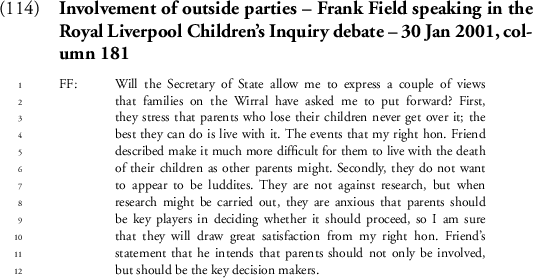
In Sect. 6.6.4, I will discuss the involvement of third parties in the composition of apologies which gives a further indication that, although MPs are the primary participants, others do collaborate in this activity type.
6.6.3.3 Structure of the Activity
Here, I will describe the typical structure of the post-inquiry apology debate and explain how ‘these structural elements [are] rationally and functionally adapted to the point of goal of the activity in question’ (Levinson 1979 : 369, his emphasis). I will also show how the activity is ‘bounded’ (Levinson 1979: 368), i.e. how it is separated from surrounding talk which is not related to being apologetic.
Openings and closings An apology debate begins with The Speaker calling the appropriate Minister to make the statement. MPs will invariably know the ‘gist’ of a statement and that an apology is to be made for a couple of reasons. Either the MP, being a senior opposition figure, has received a copy of the statement in advance or for more lowly backbench members, the title of the statement will have been included in the weekly circular referred to as ‘The Whip’6 and more details of the statement are likely to have been provided in the daily e-mail sent to each MP by her respective party Whips’ Office.
What separates this activity types from others is what is absent following The Speaker’s calling the Minister. In other types of parliamentary debate, it is very usual for the Minister rising to her feet to be met with cheers (of ‘hear, hear’) from her own side, or jeering from the Opposition benches (sometimes in the form of ironic cries of ‘hear, hear’), or both. This sort of behaviour is wholly absent from the apology debates—indeed, the House remains virtually silent throughout the whole post-inquiry statement and follow-ups, with almost no discernible remarks made from sedentary positions made during it. I will have more to say on the ‘tone’ of the debate in Sect. 6.6.3.5.
On getting to her feet, the Minister then seeks permission to make the statement, usually by saying: ‘Mr. Speaker,7 with permission I wish to make a statement on X’, where X is the topic in question. These fairly mundane, procedural statements open the activity type of the post-inquiry apology. These features are shared with other types of parliamentary activity and so the opening alone does not give a clear indication that such an activity will follow (unlike, say, The Speaker stating ‘Questions to the Prime Minister’ clearly showing that Prime Minister’s Question Time is commencing).
The Speaker closes the activity type by calling for order and usually thanking those who have contributed. He then declares that ‘we [the House] now come to the main business of the day’, which marks the end of this more ‘unusual’ business and sees the House return to its more usual function of scrutinising, debating and voting on legislation.
Sub-division The subdivision of an activity type is designed (not necessarily optimally) to reach the goal of the talk exchange. In the case of the post-inquiry apology, the ultimate goal of such an activity is disputable—and we will see this in Sect. 6.6.8 on the use of an apology for political gain or advantage, and Sect. 6.6.9 on the broader legitimacy of such apologies. To some extent what the ‘true’ goal of the activity is moot—its structure is conducive to achieving forgiveness, the settlement of a controversial issue (i.e. ‘moving on’), or helping to lift ‘inherited guilt’ (Hatch 2008: 61ff.)—all possible goals of the activity type, depending on the position one takes with respect to such statements.
Initial apology statement from the Minister—containing the background to the case, an apology and detailing any other reparations involved;
Response from Opposition—most often containing an apology as well, but at the very least welcoming the apology;
Reply from the Minister—thanking the Opposition for their support and answering any questions contained in the response;
Response from Backbenchers—usually welcoming the apology, less frequently joining in the apology. On some occasions, backbenchers accept the apology on behalf of the transgressed;
Reply from the Minister—usually praising the backbencher or thanking them for their support.
This subdivision allows for speakers from across the political spectrum to join in and welcome the apology which raises the prospect of achieving the goals of the statement—a universal apology reflecting the sentiments of all in the House may be easier for victims to accept and forgive, allowing for a settlement of the issue at hand.
That some MPs (particularly those who represent constituents affected by the events investigated by the inquiry) accept the apology may be viewed as an attempt on their part to bring the parliamentary apology closer in character to the everyday apology. It also suggests that they have been ratified by those affected to do this, and reflects the idea that a lot of backstage work (see Goffman 1959: Chapter 3) is done by participants in this activity. This is a matter which I will broach again in Sect. 6.6.4 on participation structure.
6.6.3.4 Conversational Maxims
The application of Grice’s conversation maxims varies in ‘marked’ contexts; I discussed earlier in Chapter 3 how, for instance, in courtroom discourse neither party assumes that the maxims (particularly quantity) are being fully adhered to. How the maxims are applied in parliamentary discourse has not been considered, at least to my knowledge, and if it has, it certainly has not received the kind of attention that courtroom discourse has (Chapter 10 of Tiersma (1999) is a useful introduction to implicature in the courtroom and contains a number of recommendations for further reading).
It may be the case, therefore, that what I have to say about the implicatures generated (or not generated, as the case may be) in parliamentary apologies following an inquiry, is actually applicable to other parliamentary activity types, too. It is beyond the scope of this study to look in detail at other speech events. Here, I will look in particular at how the activity type affects the interpretation of (redundant) questions.
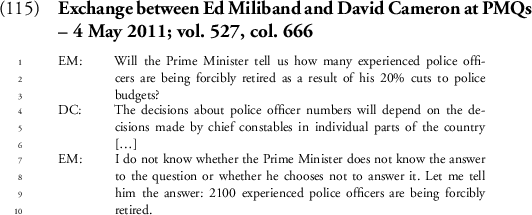
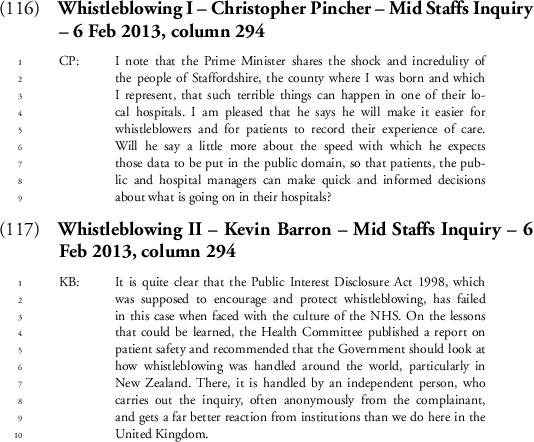

The Speaker reminds the House of what is ‘orderly’ following ministerial statements (of any type)—respondents’ contributions must be phrased as a question (lengthy preambles to questions are usually cut short by the chair). Contributors before this reminder had focussed heavily on welcoming the apology and congratulating the Minister on making it—questions were not foregrounded (or in the case of Kevin Barron—asked at all). The questions which did appear were very much ‘tagged on’ and treated similar topics. These otherwise redundant questions are used for a contribution to remain in order, and this is especially important to do after a reminder about orderly conduct from the chair. So, in this activity type a repeated question is not intended to be awkward for the Minister, but rather is likely to be a soft-ball produced only so the contribution remains within the more general parliamentary rules. A knowledge of the nature of the activity type is needed by participants so that they do not misinterpret this feature.
6.6.3.5 Tone or Style of Debate
Levinson suggests that style or tone is not an altogether important feature of the activity type (Levinson 1979: 369). Whilst it is true that the tone of some activity types is heavily dependent on the participants, for instance a chance meeting in the street will vary in tone depending on the closeness of the interlocutors, length of time between last meeting, etc., with statements resulting in an apology, tone seems to be a defining feature of the activity type. I would suggest that the nature of the event imposes certain standards in terms of the expected delivery of an utterance and the comportment of the MPs present.
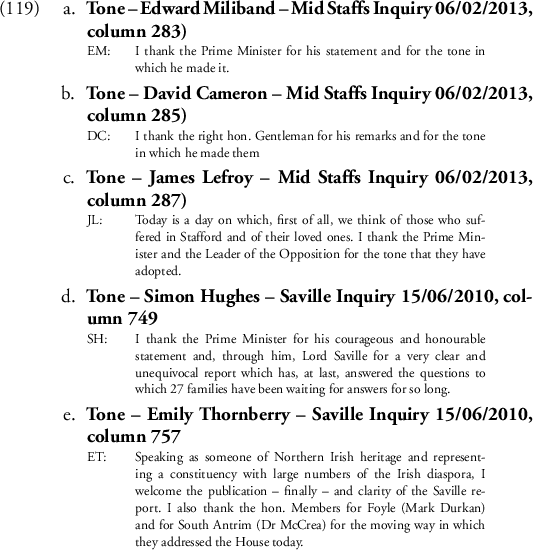
Notice that members welcome not only each other’s statements, but also the way in which they are performed. This level of overt politeness is unusual in parliamentary discourse, where disputation is more commonly found (see Murphy 2014). It is particularly marked that this sort of praise is found to take place across parties, and this plays into what I have mentioned previously that apology statements are occasions for consensus.
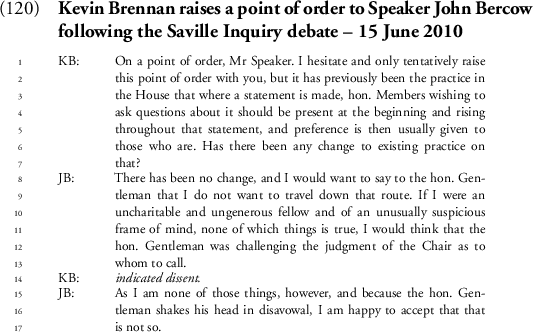
6.6.4 Participation Structure
In this section I will explore who is party to a post-inquiry apology, in other words, who is involved in its composition and who occupy the hearer roles of an apology. To this end, I draw on Levinson’s (1988) on participation structure which takes up the call to action issued by Goffman that we need to get beyond ‘the primitive notions of speaker and hearer’ (Goffman 1981: 192). Exploring these matters brings up some further differences between the post-inquiry apologies made in parliament and the apologies which are produced during oral evidence.
A speaker can be decomposed into three important components—the principal, whose feelings are represented by an utterance; the author, who plans and provides the words for the utterance; and the animator, who physically produces the utterance. In the case of an apology in everyday talk, we can well imagine that these three roles will be embodied by the same person: the person who feels bad about her actions, thinks about how to say sorry in the best way and then gives expression to the ‘script’ that she has either consciously or unconsciously planned out. However, public apologies can be more complex than this—even if some, ultimately, have the same participation structure. For instance, in the case of apologies which occur during the public inquiry, a witness who has discussed her evidence with her own legal counsel in advance of appearing before the inquiry may have been briefed on an appropriate form of words for her apology. In this case, the authorship may be shared with her counsel. However, I think it is reasonable to believe that the witness remains the principal in these cases—her feelings are likely still being represented by the apology (otherwise she may resist producing one altogether). Naturally, she is also the animator.8

Participation structure of a post-inquiry apology
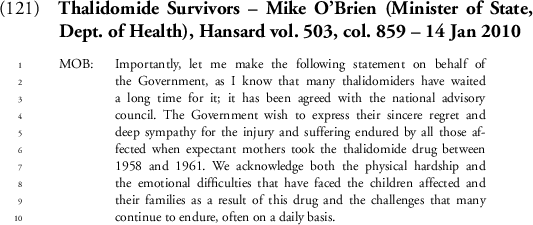

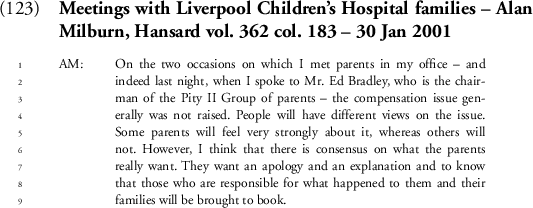
I propose that this derives from the desire to show that the apology has been deemed acceptable and has been accepted by the wronged parties—a feature which would add legitimacy to the apology. We saw earlier that some MPs accept (and at the very least, welcome) an apology on behalf of their constituents; by making it clear in the apology that the statement has received input from the offended parties, the apologiser can make clear that the apology has been welcomed by them. This acceptance would otherwise not be placed on the record and could lead to speculation that the apology has not received the support of the appropriate parties (i.e. not making clear the apology has been agreed in advance may indicate that the apology will be rejected by the apologisee). Such a fate befell one historical apology, relating to the murder of the Irish human rights lawyer Patrick Finucane who was killed by loyalist paramilitaries assisted by the collusion of British Government intelligence officers. The family of Patrick Finucane rejected the report which led to David Cameron’s apology, calling it a ‘whitewash’ and a ‘sham’ and they were particularly angered at their lack of involvement in the process that led up to the apology.9
The final aspect of participation structure which merits comment and which distinguishes post-inquiry apologies from those found at the public inquiry involves the hearer roles. I spoke earlier about how an apology given during oral evidence can be considered a tactic used by some as a means of seeking to minimise the blame that they ultimately receive. To this end, I think the recipient of the apology in these instances is not simply the people who have been wronged, but also the inquiry’s panel because the apology is intended just as much for them as it is the true apologisees. It is provided in part as a demonstration that the speaker knows that her conduct has fallen short and is contrite about that. The post-inquiry apology, on the other hand, has simply as a recipient those who were wronged—I argue (and will expand on this shortly) that these post-inquiry apologies are not self-serving. They are intended to repair relations with the group of people who have been negatively affected by the wrongdoing explored by the inquiry and outlined in the apology statement.
6.6.5 Contents of the Apology Statement
I hope to have shown evidence for the suggestion that post-inquiry apologies form a natural class of parliamentary activity, quite apart from other types of debate or questioning more usually associated with the Westminster democratic system. I have yet to say much about how the apologies themselves are worded; I take up this task here. In what follows, I show that apologising takes up only a small portion of the (Prime) Minister’s statement and that other features including: description of offence, contextualisation thereof, justification of the statement and apology and reports of what has been or is being done to remedy the offence all have a place in historical apology statements. I will look here at these contents, as well as the apology tokens proper. I will offer some discussion of why the apology elements are more or less backgrounded, as well as seeking to explain why the statements take the form that they do.
6.6.5.1 Description of Offence
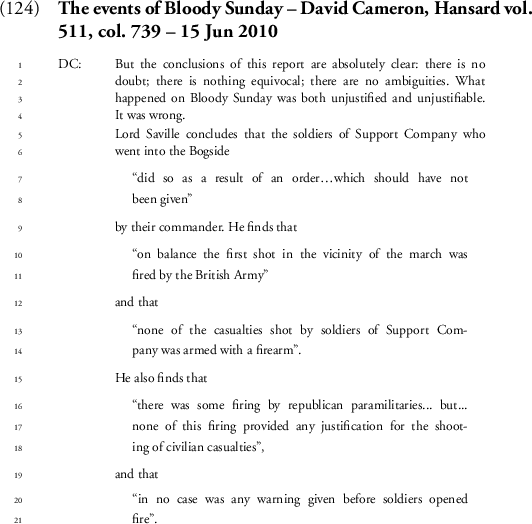
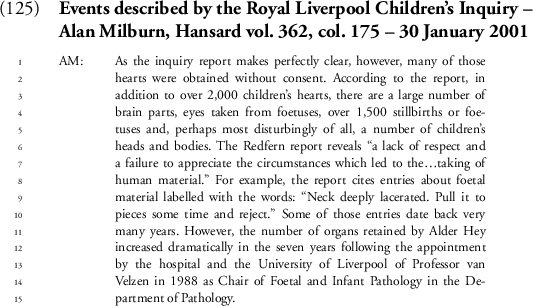
6.6.6 Reportability and Credibility
Time in apology statements is also devoted to explaining why it is ‘reportable’, to use Labov’s (2013) terminology, that is to say it is incumbent upon the apologiser to pre-emptively answer the question: ‘why this now?’. In personal narrative, this question needs to be answered because telling a story requires exceptional division of floor-time (see Sacks 1992: 3–5). In Parliament the question needs to be answered because floor time in the main chamber is a precious commodity and so the (Prime) Minister needs to be clear why the statement merits the hearing of the House at this point.

Other means of making a statement reportable include announcing a change in the law to be brought forward, or the establishment of a financial package for those affected by the transgressions (I will discuss these aspects further in Sect. 6.6.6.2), and which form an important part of some post-inquiry apologies. These matters of redress a further means of the government ‘throwing its weight behind’ the findings of the public inquiry—it shows that the minister believes in the findings of the inquiry if she is committing to implementing (some of) its recommendations.
6.6.6.1 Justifying the Apology
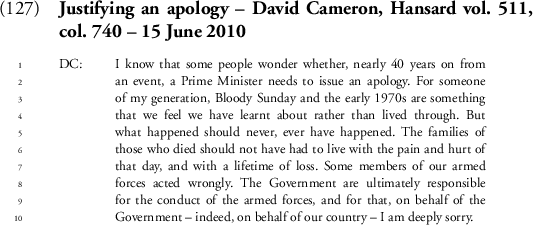
6.6.6.2 Redress and Non-recurrence
Murphy (2015) notes how personal apologies produced by Members of Parliament often contain an offer of redress (i.e. an action which seeks to ‘undo’ the damage caused by the apologisable behaviour). Personal apologies, rather than these more indirect apologies, rarely contained promises of non-recurrence (i.e. did not offer a guarantee that the behaviour would not happen again). These more impersonal post-inquiry apologies often contain one of these strategies, if not both and, since the scale of the transgressions is far greater than those which receive a run-of-the-mill political apology, this means that the redress and promises of non-recurrence have to be correspondingly more elaborate.
Removal of a number of staff from their posts (both statements);
Referral of those staff and others to the General Medical Council/Nursing and Midwifery Council for disciplinary action (both statements);
Providing of evidence to the police to see if they are able to pursue criminal prosecution of individuals (Royal Liverpool) ;
The return of organs to families who wish to have them returned (Royal Liverpool) .

Some of these potential means of redress also overlap promises of non-recurrence. For instance, the removal from their posts of workers involved in or directly responsible for transgressions may also prevent a recurrence of the offence, since those responsible are no longer in place to perform the same wrongdoing.


The drafting and introduction of new legislation to require informed consent for the retention of organs for medical research10 (Royal Liverpool) ;
The Human Tissue Act (2004) requires informed consent for organ retention (Redfern Inquiry) ;
Changes to the coronial service to introduce more checks and balances on the process of post-mortems, including more spot checks (Redfern Inquiry) ;
NHS Commissioning Board mandates new nursing standards including an increase of nursing rounds and better tracking of hospital acquired infection (Mid-Staffs);
Introduction of Patient Voice to allow patients and families to raise concerns about hospital treatment (Mid-Staffs);
Introduction of a new hospital inspection regime (Mid-Staffs).

6.6.6.3 Giving Praise
A final aspect contained in post-inquiry apology statements, aside from the apology proper, is to give praise to (some of) the recipients and/or overhearers. As far as the assignment of praise is concerned, the objects of praise are numerous and include: parliamentarians who have been involved in (extra-)Parliamentary action to publicise the apologisable events, organisers of victim groups, and any parties involved in any inquiries or investigations into the events. Particular aspects of character which are praised include campaigners’ ‘commitment’ to the championing of a cause, their tenacity or fighting spirit and their indefatigability. Victims and/or their representatives may also be the subject of praise; in these cases, it is individuals’ dignity which is marked out as being particularly praiseworthy. This is a further example of an element of this parliamentary event which is very different to other activity types in the House of Commons.
6.6.7 The Apology Proper
I now come to what might be thought of as the most important part of a post-inquiry apology statement; the apology itself. In comparison to the rest of the ministerial statement, however, it can be seen that that the apology proper is particularly brief—in most cases it takes up less than 3% of the entire statement (based on a simple line count in the transcript). Table 6.2 shows the forms of the explicit and conventional apology tokens which are found in the post-inquiry apologies:
Earlier I explored the distinction between direct and indirect apologies, and how tokens like I apologise are an explicit means of apologising, whilst I’m sorry conventionally performs an apology, but is also associated with neighbouring speech acts like expressing sympathy. What is curious about the apology tokens within the post-inquiry statements is that there is a preference for indirect apologies, i.e. ones which are done through implicature, over unequivocal apologies. This is not just the case with ministers using sorrow-related expressions, but also their use of the verb apologise is not performative, instead it is embedded in relatively complex constructions indicating desire to carry out the action. This mirrors what was found in the apologies found during the oral evidence.
Explicit and conventional apology tokens found in historical apologies
Debate title | Apology token(s) |
|---|---|
Royal Liverpool Children’s Inquiry | I am deeply sorry for the wrong that was done to them, their families and their children |
Saville Inquiry | The Government are ultimately responsible for the conduct of the armed forces, and for that, on behalf of the Government—indeed, on behalf of our country—I am deeply sorry |
Redfern Inquiry | There is no time limit on grief; nor is there on apologies. I would like to take this opportunity to express my heartfelt regret, and to apologise to the families and relatives of those involved |
Mid-Staffordshire NHS Foundation Trust (Inquiry) | The previous Government commissioned the first report from Robert Francis. When he saw that report, the former Secretary of State—now the shadow Health Secretary, the right hon. Member for Leigh (Andy Burnham)—was right to apologise for what went wrong. This public inquiry not only repeats earlier findings, but shows wider systemic failings, so I would like to go further as Prime Minister and apologise to the families of all those who have suffered for the way the system allowed this horrific abuse to go unchecked and unchallenged for so long. On behalf of the Government—and, indeed, our country—I am truly sorry |
A more cynical possible explanation for the absence of explicit apologies is that of deniability. In the previous chapter, we saw how this was also a possible motivation for avoiding explicit blame in the inquiry reports. In a situation where a victim group was to take the Government to court to sue for damages, an explicit apology might be cited as an acceptance of responsibility on the part of the Government. By using an generalised conversational implicature, the Government gives itself a possible ‘out’ in court, and could argue that their statement represented only an expression of sympathy with the victims and that the current government can bear no responsibility. Of course, this would be difficult to argue where statements explicitly take on the responsibility, but the possibility for a legal argument is, at least, there.

6.6.8 Using Apologies as a Political Weapon
Some may accuse me of being overly generous in my view of post-inquiry apologies—that I have given a positive view of the politicians who produce them, and not thought about the ‘ulterior’ motives associated with such statements. This is perhaps a fair comment, but I would counter it by arguing that these statements can and do have positive effects for their recipients. For instance, watching David Cameron’s statement on a big screen placed outside the Guild Hall in Derry, families caught up in the events of Bloody Sunday rejoiced following Cameron’s apology. Many speakers at that event welcomed not only the inquiry report, but also the response of political figures in the House of Commons.11
However, there are times when these post-inquiry apologies do other work, aside from the positive attempts to bring marginalised groups back into the fold of civic society. There are sometimes more cynical, base, political motivations. I think this is particularly the case with the Mid-Staffordshire NHS Foundation Trust public inquiry and the subsequent apology statement. Some further context to the events which triggered the inquiry, the establishment of the inquiry itself and its outcomes may help to support this view.
According to the findings of the The Mid-Staffordshire NHS Foundation Trust Inquiry, ‘[b]etween 2005 and 2008 conditions of appalling care were able to flourish in the main hospital serving the people of Stafford and its surrounding area’ (Francis 2013: 3). This was a period during which the Labour Party were in government and, therefore, ultimately responsible for the standards of care in the National Health Service. When the Healthcare Commission, which was responsible for inspecting hospitals, reported to the then Labour Health Secretary Alan Johnson of the serious failings in the Trust in March 2009, he apologised in the House of Commons. However, pressure continued to mount on the Labour government—healthcare campaigners believed that the Healthcare Commission report did not go far enough and did not uncover the root causes of the problems in the Trust.
A non-statutory inquiry was established to explore patient experience (i.e. an inquiry which is not set up under the Inquiries Act (2005) and therefore not within the scope of this study). The findings of the report were highly damaging for the Labour Pary; they revealed shocking treatment of patients, including cases of patients being left without water for so long that they resorted to drinking from vases. Whilst the report uncovered appalling experiences, campaigners including Julie Bailey whose mother died at Stafford Hospital, pressured the government to establish an inquiry into the wider causes of the scandal. Separately from Bailey’s Cure the NHS pressure group, the opposition Conservative Party picked up the case of Mid-Staffs and used it as an issue in pre-election campaigning. Perhaps in order to push the issue into the long grass as work by Sulitzeanu-Kenan (2007) suggests, Johnson’s successor as Health Secretary, Andy Burnham ordered a second non-statutory inquiry into these wider issues.
The Labour Party, as the party which founded the NHS in 1948, has tended to be trusted with its management, whilst the Conservatives have historically avoided focus on the NHS when it comes to their election messaging (see Ashcroft 2015). But sensing Labour’s weakness in light of the scandal in Stafford, the Conservative Party made one of their central campaigning planks: ‘We’ll cut the deficit not the NHS’. Moreover, the failures at Mid-Staffs were used as a stick with which to beat the Labour Party—articles appeared in the press in the run-up to election entitled: ‘Get your mum out of here: Even top doc warned of filthy ward NHS crisis’ (The Sun: 13 March 2010); ‘Labour hid ugly truths about the NHS’ (The Times: 7 March 2010); ‘Watchdog tells 12 NHS Flagship hospitals to raise standards; Labour’s ‘gold standard’ make up more than half the commission’s hit list’ (The Independent: 2 April 2010).
Labour ultimately lost the General Election in 2010, and the Conservative Party formed a coalition with the Liberal Democrats.
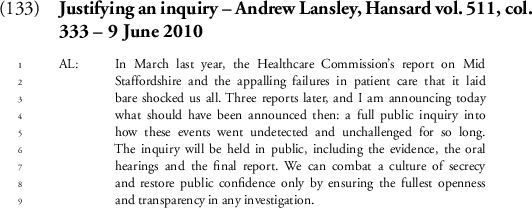
And that view may be extended to Cameron’s ultimate apology following the reporting of the public inquiry. Whilst there are good reasons for offering a full and frank description of the offences being apologised for which I outlined earlier in Sect. 6.6.5.1, in this case it had the additional effect of causing still more damage to Labour Party. Earlier, I suggested that apologies can be conceived of as being self-blaming actions, but this example of a post-inquiry apology is different from the others, in that it is probably better thought of as an action which underlines the blame felt by a political opponent.
Blaming in this way, by apologising on behalf of the nation, is politically canny. Given what I explained earlier about the consensual nature of this activity type, it is very difficult for the opposition to do anything but join in with the apology and thus accept more direct responsibility for the events outlined. It is also virtually impossible to question the motives of the apologiser—it would seem churlish to say the least for the Leader of the Opposition to suggest that the Prime Minister was only apologising because he wanted to damage the Labour Party.12 Moreover, reminding the public of Burnham’s apology at the time of the events may not be done to demonstrate consensus but to reinforce the culpability of the previous Labour administration. Explicitly naming Burnham and reminding the public of his role as Labour spokesman on health strengthens the potency of the potential for blame against Cameron’s political opponents.
Drawing on a trusted institution like a public inquiry to frame criticism of political opponents is likely to be more effective than other sources which might more easily be dismissed as a political smear. Indeed, the issues which were raised by the Mid-Staffs Inquiry dogged the Labour Party, and particularly Andy Burnham. Reviewing the debate between Health spokespeople during the 2015 General Election, James Forsyth writing in The Spectator said, ‘Burnham was on hectoring form throughout the debate. But he struggled so badly to answer Andrew Neil’s questions about Mid Staffs that one was left feeling he’ll never be able to win a Labour leadership contest until he has a proper answer to these questions’.13
This politically astute use of public inquiries and their findings, as well as endorsing their findings with a post-inquiry apology, is perhaps a reason why some politicians are reluctant to establish inquiries in the first place. It also potentially explains the delay between the offences in question and the initiation of the inquiry—it means their potential potency at a party political level is diminished.
6.6.9 Are Post-inquiry Apologies Legitimate?
The final aspect of post-inquiry apologies which merits discussion is whether they are a legitimate thing for politicians to engage in. I have suggested that, whilst they can have the function of highlighting the blameworthy conduct of political opponents, for the most part they are used to seek to remedy damage done by the government (if not both things simultaneously).
These post-inquiry apologies mostly relate to matters which can be considered historic in nature—the minister apologising was not directly responsible for the action in question, and at least in the case of then Prime Minister, David Cameron apologising after the Saville Inquiry, may not even have been a political actor at the time of the negative action. Cameron was just six years old on Bloody Sunday. These post-inquiry apologies tend, therefore, to belong to a wider category of historical apologies which has been discussed extensively in the literature on peace and reconciliation (see Andrieu 2009; Bar-Siman-Tov 2004; Gibney et al. 2008; Tavuchis 1991).
But a number of journalists and high-profile figures have criticised the trend for politicians to apologise for historical wrongdoing—‘the sins of the nation’. The main contentious issue with these apologies is that the apologiser did not commit the wrongdoing. I touched on this briefly in Sect. 6.6.4, but develop it further here. Further criticisms about politicians apologising for historic wrongs have come from a number of sources (including: Gardiner and Roach 2009; Somani 2011). Many of these grievances were cogently discussed by Jonathan Sumption, a historian and now Supreme Court judge, on BBC Radio 4’s lecture series ‘Four Thought’. In his talk, ‘Don’t Apologise’, first broadcast on 4 May 2011, Sumption argued against historical apologies for a number of reasons. In this section, I will outline some of his points, discussing possible arguments against his criticisms.
6.6.9.1 Apologiser  Transgressor
Transgressor
One of the most commonly encountered criticisms of apologies for historical wrongdoing (of which post-inquiry apologies are the type under discussion here) is that the apologiser is not the person who committed the negative acts. One way to get beyond this is to think about whether or not the apology is acceptable for those who are its intended recipients. In other words, if the perlocutionary goal of the apology has been achieved, then it can be considered legitimate. I have shown that these post-inquiry apologies do meet this standard, and so if they are acceptable for the group for whom they are intended, then in my view it is difficult to question their legitimacy.
There is, however, further justification for believing these apologies to be acceptable, other than their having been accepted by victims’ groups. Goffman suggests that when apologising, the apologiser splits herself into two parts—the wrongdoing part, guilty of the offence and a part which ‘stands back and sympathizes with the blame giving, and, by implication, is worthy of being brought back into the fold’ (Goffman 1971: 113). Is this is what is going on when political figures perform post-inquiry apologies? At an even more abstract level, I think so. In performing an apology, the Prime Minister (or other senior figure) is not splitting herself in two (as would be the case with a personal apology), but rather her position of authority allows her to split the nation in two. The (senior) politician is able to do this because i) she is democratically elected by the members of the nation and ii) she is part of a government which has inherited the laws and deeds of previous governments, meaning that they have some connection to the wrongdoing, albeit a less than substantial one. This form of responsibility by virtue of the role that one holds adds legitimacy to these apologies. I would accept that this is may seem a rather grandiose explanation, but I hope the reader will indulge me in this case.
6.6.9.2 The Status of the Offence
He goes on to say that:Medieval crusaders and inquisitors ought to have taken the same view in their own day about morality and religious violence as he himself was taking at the dawn of the 21st Century.
when we castigate the sins of our forebears as immoral, we are saying, implicitly, that there are some moral principles which are absolute and eternal, not relative and ephemeral by which men may be justly judged in any age.
The problem with this type of argument is that it means the only legitimate apology would be for an action which the apologiser knew was wrong when she performed it. Moreover, it would mean that a person whose moral convictions change at a later date need not apologise for actions which contravene this new moral code, because they did not contravene the old one. In the case of the apologies we make in our everyday lives, this certainly seems untenable. I am sure that most people will have experienced an occasion when they did something which they thought at the time was right, and only later came to regret and apologise for. The same principle can surely apply to nations and institutions, but given their size (and the difference in the nature of the offences they commit), the timescales involved are correspondingly larger. This almost inevitably means that the people in charge at the time of the offences are no longer alive when the apologies are made. The apology which is then made does not implicitly suggest that there are morals which are absolute and eternal, but merely draws attention to the fact that our morals have changed and gives an opportunity for the apologiser to explain how and why they have changed. This should be reminiscent of what I said earlier that one of the more foregrounded functions of these post-inquiry statements is to outline what the government has done or will do to change to prevent recurrence of these negative acts.
6.6.9.3 Engaging with Responsibility
Yet, in what sense am I responsible? I am descended from nineteenth century Englishmen, I live in the same country they did, and I speak the same language. But I didn’t do it! You didn’t do it! It wasn’t done on our behalf.
As a number of the examples discussed earlier have shown, the apologiser frequently references the idea that she is apologising on behalf of the government and the nation (see for instance, Cameron’s apology after the Mid-Staffs Inquiry shown in Table 6.2). Such a formulation does not, I believe, engage the moral responsibility of the individual but rather abstracts it away to the level of the state.
6.6.9.4 Victimhood and the Absent Victims
it was suggested [the apology] was due to those dispersed descendants of the original slaves who are alive today. And it is not obvious what injury has been done to them. In what sense, other than a purely genealogical one, do they represent the victims of the original wrong.
We apologise to be forgiven. [...] But who is in a position to grant absolution for the sins of my ancestors against a long-dead generation. To promote forgiveness in that situation, you have to create an entirely artificial class of victims.
Whilst it is the case that the purpose of the interpersonal apology is prototypically to be forgiven, does this apply to post-inquiry and other historical apologies? I do not believe so. It is my opinion, and one held by others (i.a. Weyeneth 2001: 23ff.), that apologies for historic wrongs have a primary purpose of a nation (or government) making clear what its ideals and beliefs are. The apology serves, to some extent, to act as a firewall between a time when offences were committed and accepted and the time after the apology, when such actions will be not be carried out or supported (promises of non-recurrence form a major part of these apologies, as I showed earlier). Forgiveness is a secondary aim. As a result, it seems to me that there is no real need for their to be a victim for the apology to be directed to. However, in the case of the post-inquiry apologies, they often do have clear recipients and so this type of criticism is not reasonable in any case.
6.6.9.5 Summary
I have, I believe, shown why post-inquiry apologies are justifiable. This does not mean that they are without controversy and this gives some explanation for why some Ministers spend time explaining why they think it is important to carry out an apology despite some of the criticisms I have explored here. My key reason for believing in the legitimacy of apologies produced after a public inquiry comes back to the views of affected parties, their friends and families. For those groups, who are directly involved in the apology statements, these ministerial actions are important and valued. The apologies acknowledge the frustration, sadness, anger, etc. felt by the offended parties and acknowledge that they were justified in feeling this way. Moreover, the apologies are at least an attempt to bring about a return to normal relations between the state and the wronged parties.
6.6.10 Conclusion
In this section, I have discussed parliamentary post-inquiry apologies and hope to have shown their importance in the democratic workings of a modern, civilised country.
I showed how parliamentary apology statements and the ensuing question period are virtually unique as a parliamentary activity. Rather than being subject to intense debate and division as is often the case in Parliament, we have seen that post-inquiry apology statements see the House come together in consensus. Moreover, the House is quiet with an absence of jeering or heckling from a sedentary position and the questions that are asked are best characterised as being ‘softballs’. These aspects stem from the serious and often moving nature of the statements and what is contained therein.
The statements themselves focus less on apologising (though this, of course, happens) and more on ‘getting the truth out’ in detailed descriptions of the offence(s). This is a necessary component of these statements since the truth has so often been obscured before these apologies and the inquiries which triggered them. The potentially disturbing detail is not shied away from in the statements because the apologiser is not the transgressor and so her personal face is not threatened by giving such detail.
Finally, we saw that the apology tokens contained in the statement are invariably conventional in nature. This may be because the apologiser has frequently negotiated the form of the apology in advance with the offended parties and so the risk of the apology being misinterpreted is that much lower.
6.7 Conclusion
In this chapter I have focussed on the performance of one speech act—namely apologies—at various stages of the inquiry process. The motivation for this comes out of the instrinsic link between blame and apologising—they are associated by an underlying negative action. Blame involves the assignment of responsibility for a negative action, whereas apologising can contain a tacit acceptance of, and seeks to remedy the interpersonal damage caused by, a negative action.
In considering apologies, I explored their performance at three separate stages: before, during and after an inquiry. Pre-inquiry apologies, as one would imagine, are the most marginal of these actions and are given only for offences which are not to be investigated under the inquiry’s Terms of Reference. They tend to be given by government figures for the delay in getting to be the bottom of matters which the inquiry is tasked to find out, and for a failure to engage core participants in the process of selecting a panel for the inquiry. As such, they are a form of meta-apology; they relate to the conduct of an inquiry, rather than anything which the chair is likely to come to blame an apologiser for. In a sense, this is to be expected; if an apology were given for a matter which is being investigated, it would undermine the need for the inquiry to happen in the first place.
Apologies during the inquiry are an interesting phenomenon—one would expect them to be avoided since, as I have noted, they can be considered a self-blaming action (a view which is shared by Adams 1999: 235ff.). However, we do see a number of examples of apologies from witnesses during their oral evidence. I suspect the reason for this relates to the question of sincerity. An apologiser who recognises that her actions are negative without being explicitly told is likely to be viewed as more sincere in her desire to repair interpersonal relations, than one who appears only to be apologising because she has been forced to. That having been said, the fact that these apologies tend to occur at the end of a witness’ oral evidence give an indication that calculations are made about the likelihood that blame is incipient. After having heard the questions of counsel, a witness is able to form an impression about whether her conduct is likely to be viewed negatively or not. In so doing, she undertakes a cost-benefits analysis: will the benefit that comes from pre-empting blame by apologising be outweighed by the cost to face and/or political cost inherent in apologising? A means that many apologisers use to reduce the potential cost of apologising is to provide an account of their behaviour, which, as noted earlier, can see the amount of blame reduced. The performance of these apologies is also noteworthy. They tend to be indirect, with the witness implicating that she is apologising, rather than explicitly doing so. As such, impressions of sorrow and wishing to apologise are invoked. Part of the reason for this is so that the witness can give an impression of apologising without fully committing to this position, which could also be a helpful means of reducing the potential (legal) cost of an overt apology.
Finally, I explored apologies which come from the government after an inquiry has published its report. I discussed the contested legitimacy of apologies for historical wrongdoing, but came to the view that they are an appropriate action. Whilst an apologising minister may not be directly and personally responsible for the actions under discussion, she has an indirect responsibility by virtue of the position she holds. Apologising by the government is a means for it to accept and endorse the legitimacy of an inquiry and its findings, which is important for the status of public inquiries in the future. Moreover, if personal apologies are about repairing damaged interpersonal relationships, then public statements of contrition can be viewed as a means of the state trying to welcome a marginalised group back into civic society; in other words, they are a starting point for a normalisation of relations between the transgressing state/state actors and people who were badly affected by their negative actions.
Putting to one side questions of the legitimacy of such statements, I introduced the notion of the activity type as applied to the parliamentary performances in which the apologies are found. I drew attention to the exceptional nature of these events, and how they tend to be built on consensus across all parties in the House of Commons, rather than the usual disputatious nature of talk in that setting. I also noted how, rather than the accounting behaviours found at the inquiry, post-inquiry apologies are stark in their description of the negative actions under discussion and do not seek to shy away from (a previous) government’s responsibility for them. It is this lack of a direct link of responsibility that allows this unflinching apology—the apologiser’s personal face is not at risk here. That having been said, the apology is accompanied by statements of redress —i.e. explanations by the government about what will happen next to remedy the damage done (either to prevent recurrence or to provide support for those negatively affected). I also drew attention to the fact that these statements can have base, party political motivations. I fear that such uses undermine the otherwise important work which can be undertaken with this parliamentary activity.

